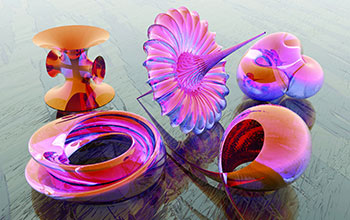Multimedia Gallery
"Still Life: Five Glass Surfaces on a Tabletop"
Innumerable surfaces that we cannot touch or see or even know can be seen by mathematicians. They have long relied on their powers of imagination to picture abstract surfaces. In this image, titled "Still Life: Five Glass Surfaces on a Tabletop," Richard Palais of the University of California, Irvine, and graphic artist Luc Benard used the magic of computer graphics to recreate these abstract surfaces in familiar yet intriguing settings.
This image won first place in the Illustration category of the 2006 Science and Engineering Visualization Challenge (SciVis). The competition is sponsored by the National Science Foundation and the journal Science. To learn more about the SciVis competition, see the SciVis Special Report Here . (Date of Image: May 2006)
More about this Image
To most of us, a surface is something we can touch and attribute a shape to -- such as the spherical surface of a ball or the toroidal surface of a doughnut. But there are innumerable surfaces too complex for us to see, touch or know that exist in the mathematician's world of abstract form. To mathematicians, surfaces are representations of mathematical functions, a concept more general and abstract than the boundary of a solid physical object. The working lives of mathematicians revolve around many abstract concepts, of which a mathematical surface is an important example and, from time immemorial, mathematicians have had to rely on their power of imagination to visualize their surfaces. Now, mathematicians like Richard Palais of the University of California, Irvine, and graphic artists like Luc Benard have been cooperating to use the magic of computer graphics to recreate abstract mathematical surfaces in concrete, familiar and intriguing settings for anyone to see.
This illustration "Still Life: Five Glass Surfaces on a Tabletop" presents five, well-known mathematical surfaces, rendered as glass objects in a highly realistic "still life." To create their chosen mathematical surfaces, Luc Benard used the computer program 3D-XplorMath, developed by Palais as a "virtual mathematical museum," in that it has to build into it, all the mathematical knowledge required to visualize accurate models of many of the most famous and mathematically interesting surfaces, as well as other geometric objects.
Then, Luc exported these surfaces from 3D-XplorMath into a 3D rendering program, using it to give the objects a "glassy texture" and placing them on a virtual "glass-covered wooden table-top." Judging panel member Felice Frankel was impressed by the image's ability to engage a viewer and trigger their curiosity. "That is what we strive for in any visual experiment, that we are creating curiosity by engaging each other (visually)," she says. "That is how we can learn from one another."
Credit: Richard Palais, University of California, Irvine; Luc Benard
See other images like this on your iPhone or iPad download NSF Science Zone on the Apple App Store.
Images and other media in the National Science Foundation Multimedia Gallery are available for use in print and electronic material by NSF employees, members of the media, university staff, teachers and the general public. All media in the gallery are intended for personal, educational and nonprofit/non-commercial use only.
Images credited to the National Science Foundation, a federal agency, are in the public domain. The images were created by employees of the United States Government as part of their official duties or prepared by contractors as "works for hire" for NSF. You may freely use NSF-credited images and, at your discretion, credit NSF with a "Courtesy: National Science Foundation" notation.
Additional information about general usage can be found in Conditions.
Also Available:
Download the high-resolution JPG version of the image. (2.4 MB)
Use your mouse to right-click (Mac users may need to Ctrl-click) the link above and choose the option that will save the file or target to your computer.



